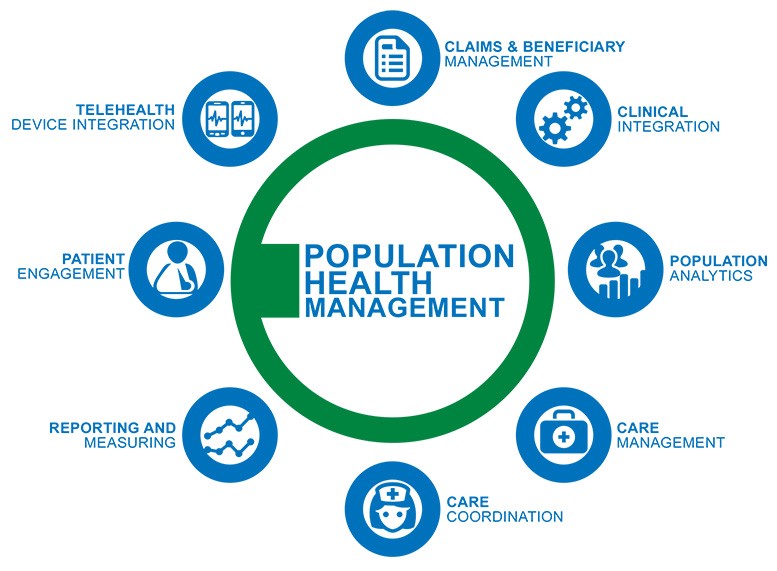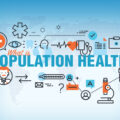Population health management (PHM) refers to a concentrated holistic approach to improving the patient health outcomes of a group of individuals. These individuals are part of a larger group that could consist of people within a predetermined health system, a geographic area, those with a specific disease, or ones sharing another defining characteristic. The move away from patient fee-for-service to a value-based model has made managing population health the focus for most Accountable Care Organizations (ACO), insurance providers, quality improvement agencies, health care systems, and healthcare providers as they strive for the provision of quality care at less cost.
PHM involves applying public health concepts to chronic disease management with a comprehensive data analysis. The goal includes seeking methods to improve patient outcomes and control overall costs. The information gathered can assist in finding and filling patient care gaps and developing actionable treatment steps to care for individual patients or specific groups. A provider may benefit from implementing PHM strategies as it can aid in the transition to value-based care and reimbursement.
Goals and Key considerations for population health management
The goal of population health is the systematic and transparent delivery of services to improve the health status of a given population at a prospective price, ultimately delivering better outcomes at a lower cost.
Population health management reflects a new care delivery model that emphasizes wellness and prevention and requires new payment models that support that goal. Rather than making money on high-cost procedures and episodes, healthcare delivery organizations will focus on preventing them from occurring. This doesn’t mean rationing care… it means ensuring that each patient gets the right treatment at the right time in the right setting.
By managing health problems at the least expensive point of care, healthcare delivery organizations will be able to lower total costs and redefine “healthcare” to include more than just “sick care.” Building the capabilities, infrastructure, and culture required to successfully transition to population health management is a significant challenge that demands an investment of time and capital, but the reward will be a marketable approach to maximizing the health of a population that improves the bottom line and paves the way for future delivery and payment models.
Capabilities
The ultimate goal of population health management is to improve the health of a population by engaging patients as consumers in making better choices about their own health, supporting wellness, and providing the right care at the earliest practical time at the most cost-effective point in the care continuum. This is a significant departure from current operations at many health systems and will require developing new clinical, analytic, and coordination capabilities.
At the clinical level, providers will need to develop and implement care protocols based on best practices, clinical guidelines, and peer-reviewed literature. Care protocols should be tailored to a specific patient population for both acute care episodes and chronic disease management, and should consider the continuum of care to ensure that patients are engaged and managed appropriately at all points in their treatment.
New analytic capabilities will be required to support the implementation of new clinical practices and goals, and to facilitate the alignment of incentives across the organization. Relevant outcome metrics will need to be captured, tracked, and reported in an actionable manner so that clinicians and administrators can understand where progress is occurring and where gaps remain. Similarly, a new approach to financial analytics should tie new cost accounting capabilities to relevant clinical units, putting information about the cost ramifications of different clinical behaviors into the hands of those who will be held accountable.
Coordination of patient care across the continuum is currently rudimentary. Such coordination is inhibited by multiple IT systems that don’t interface, and even more so by a clinical culture that places little value on continuity across points of care. New processes, role responsibilities, and accountabilities will need to be put in place to address this deficit, even after the technical challenges are dealt with.
Infrastructure
In the current healthcare model, the hospital is king. Population health management requires systems to rethink their care delivery model in a way that moves patients away from acute care settings by emphasizing prevention and engaging patients in active disease management and prevention. For many systems, empty acute care beds will be repurposed for long-term care, rehab, observation units, and other points along with care in the continuum.
New goals may require roles, reporting relationships, and accountabilities to be redefined. Some functions may be expanded, while others may need to be repurposed. This process will require a critical assessment of organizational strengths and gaps, and developing a plan to best deploy resources. Systems will also need to rethink their relationships with external providers. While the current healthcare environment is experiencing record rates of consolidation, many organizations are finding that strategic partnerships with outside provider organizations, done effectively, can provide patient coordination across the continuum without the capital expenditure to buy the entire range of services needed.
Culture
Population health management is not just a change in operations… it’s a major change in the culture of healthcare delivery. Executive management and the board of directors will play a critical role in creating a culture of leadership and innovation. Once leadership is committed to pursuing population health and value-based care models, they must drive culture change throughout the organization that can support and sustain this goal. Such change involves setting performance goals that are aligned with new objectives, engaging clinical staff as they work to meet new cost and quality goals, and ensuring that the commitment to delivering value is reinforced through reward, recognition, accountability mechanisms, and cultural norms throughout the organization. Physicians should be empowered as leaders to drive innovation in a way that emphasizes utilizing best practices to provide patients the best care. Goals, objectives, and progress should be clearly communicated throughout the organization in order to engage and inform all relevant staff members.
Elements For Population Health Management (PHM)
PHM requires a combination of clinical, financial, and operational data that can provide actionable steps and predictable analytics. This information is gathered through the utilization of health IT. Health IT is most beneficial when it can monitor and analyze data about a patient population, provide the ability to draw conclusions from the data, and then develop a clinical picture of a population to help manage the specific diseases within it.
Although data collection and technology are essential for PHM, a few other elements are beneficial in improving the health outcomes of a specific patient population. Those include:
Robust care management is cohesive and features well-managed objectives supported by the provider and the patient. These objectives can vary based on organizational goals, but most focus on improving the patient’s ability to self-manage their care and medication. Patient compliance and self-motivation can contribute to the reduction of the cost of care and readmission.
Data collection that can provide real-time insights and information regarding social determinants and claims data. This should include tools to track, analyze and submit data that is required to report for financial incentives and in meeting compliance regulations.
Utilizing patient risk scores regarding health, lifestyle, and medical history to create subpopulations through the division of a patient population. This method of risk stratification can help provider understand their health care needs and trends.
The creation of a complete, comprehensive patient population profile can assist with identifying patients at risk for readmission and creating patient-specific care plans.
The motivation to act with information gathered using efficient EHR technology that could assist with notifying patients, making appointments, referring, and securely sharing data within the network.
Striving to empower patients to have a higher level of engagement, education, and participation in their care. The provision of tools, resources, clinical support, and methods of prevention and care self-management can assist in keeping the patient motivated to make and maintain changes outside of the care setting.
Benefits Of Population Health Management
PHM can help in determining how to make evidence-based decisions from data analysis. This can assist in choosing how to best allocate resources across health care settings to improve organized efforts to coordinate clinical care at lower costs. The information gathered from comprehensive PHM data collection can provide an overall picture of the risk, incidence, prevalence, and trends of chronic diseases to compare and benchmark across providers.
With a growing aging population and chronic disease burden, PHM can provide the ability to be proactive with health care treatment and prevention. This may aid in empowering patients to play a bigger role in managing their health. Other potential benefits of PHM include:
Financial improvement for the organization may occur by determining the utilization of necessary services to assist in the mitigation of costs.
Better health outcomes with a focus on the prevention and management of chronic diseases and the identification of care gaps by assessing the health of the patient population. This can enable the provider to identify the greatest health care needs of the patient population for improved disease management and the appropriate allocation of health care resources.
Increased patient engagement and the motivation to maintain wellness through preventative care may assist patients with improvement before moving into high-risk groups.
What are models of population health?
In discussing models of population health, it is important to acknowledge that no single widely accepted definition of population health exists. Models of population health differ not only in their implicit or explicit definitions of population health but in other key ways as well. They include different categories of factors affecting population health and vary in their relative emphases on certain categories.
- depict different causal relationships among factors, and between those factors and population health.
- represent interactions among factors differently.
- vary in their presentation of factors as actually determining population health rather than influencing it.
- differ in their distinction between population health and individual health, and the relative influence of various factors on each.
Underlying the differences among models are differences in their definitions of population health. Careful attention to these differences can help in the elucidation of assumptions about the nature of population health and the factors that should be addressed in population health research, programs, and policies.
Contemporary conceptual discussions of population health have been generated within academia, within public health practice, and among policymakers, and in Canada, the United Kingdom, other European countries, and the United States. These discussions have been accompanied by a wealth of research on the relationship of various factors to health, sometimes at the population level and sometimes at the individual level. These include social factors (inequalities, support, cohesion, structure, stress), natural environment, socioeconomic factors (material resources at the individual level, income inequality at the contextual level), biology and early childhood development, and the built environment (e.g., transportation). Less studied, although highly relevant, is the political context in which health and intersectoral policies affect the relative salience of each of these categories of influence.
Leading the Charge to Population Health
The landscape for healthcare is changing rapidly. Demands for better outcomes and lower costs will only grow, and the differences between health and healthcare have taken center stage. As provider organizations begin to tackle the challenge of managing population health, they’ll need to develop a systematic approach to quality improvement and how it’s measured across the continuum of care. The practical demands of managing population health are huge – and require underlying cultural and operational shifts. The sooner healthcare leaders get started, the more likely they will be to have a successful “takeoff”.





